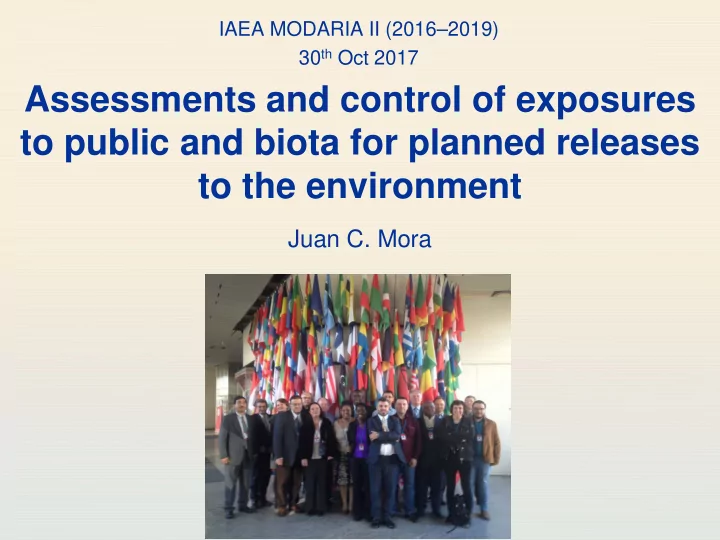

IAEA MODARIA II (2016–2019) 30 th Oct 2017 Assessments and control of exposures to public and biota for planned releases to the environment Juan C. Mora IAEA International Atomic Energy Agency
Problem to be addressed • The paradigm “ the standards of environmental control needed to protect the general public would ensure that other species were not put at risk ” changed to “ the need to be able to demonstrate (rather than to assume) that the environment is being protected against radionuclides ”. • “Establish a consistent and comprehensive basis for the proper protection of people and the environment against radiation risks […] without unduly limiting the operation of facilities .” IAEA
1 st INTERIM MEETING USA - Washington DC (US-Nuclear Regulatory Commission Headquarters) (15-18 May 2017) IAEA
General information - People attending – 23 (13 from USA) - Countries - 9 - 22 presentations - 3 technical visits (NRC, NIST, Calvert Cliff NPP) IAEA
WG3: Working steps (Chapters) 1. Identify practical international and national guidance for the demonstration of the compliance with requirements for the protection of the environment against ionizing radiations ( Stephanie Bush- Goddard ). 2. Identify state of the art tools, sources of data and methods for performing dose assessments in routine radioactive discharges which can be used in integrated assessments of the humans and the biota, including uncertainties ( Justin Smith ). 3. Study, Validate and Incorporate H3 and C14 state of the art models ( Volodymyr Korolevych + Nana Kwamena ) 4. Identify a set of cases and scenarios where explicit assessment of the environment would be necessary ( Iuri Bonchuk + Kapil Deo Singh ). 5. Carry out dose assessments for humans and the biota in those scenarios with associated uncertainty analysis ( Anca Melintescu + Dan Galeriu ). 6. Reduce the number of surrogate species which are used in dedicated dose assessment in terms of reverse modelling. Considerations on endangered species ( Benoit Charrasse + Amanda Andersson ) 7. Communication with stakeholders ( Cecile Boyer + Elisabeth Leclerc ) 8. Evaluate and compare models, approaches, parameters and other characteristics used in the assessments ( Benjamin Zorko + JC Mora ). 9. Discuss the results and give advice to the IAEA on needs and gaps ( JC Mora ). IAEA
WG3: What has been done Dose assessments for humans Dose assessments for biota Dose assessments for humans Dose assessments for biota Atmospheric discharges Lake discharges Source term details Source term details Annual discharge of each radionuclide Bq y -1 Annual discharge of each radionuclide Bq y -1 Annual (Average or pdf) discharge of each Or Annual discharge of each radionuclide Bq y -1 Or radionuclide Bq y -1 Averaged or pdfs concentrations measured in Averaged or pdfs concentrations measured in each environmental compartment (air and each environmental compartment (water and soil). sediments). Model type Model type Gaussian plume model Box model (original equations dynamic, but Key model inputs into the code only equilibrium conditions are considered) Release height, distance from release, Key model inputs roughness length, deposition velocity, met Flow rate of the income river. data based on D Pasquill stability category and Flow rate of the discharge. wind speed. Depth of the lake. Model configuration (eg calculation domain) Total average volume of the lake. Uniform distribution calculated in the centre Load of suspended sediments of the gaussian plume. Model valid up to 80 km Kd from the installation. Bioaccumulation factors (animals and Model outputs vegetables) (please provide details of endpoints and what they represent eg mean, maximum, Model configuration (eg calculation domain) Homogeneous and instantaneous mix along percentile – at a single distance or averaged over an area/volume) the complete volume of the lake. Deterministic or stochastic pdfs obtained No spatial resolution, although the dynamic based on pdf defined for each input data or model can easily be implemented. parameter along the model Model outputs (please provide details of endpoints and what they represent eg mean, maximum, For each sector and distance: percentile – at a single distance or averaged over an area/volume) Activity concentration in air at ground level Water and sediments concentrations (Bq m -3 ) (deterministic and probabilistic) Total deposition rate (Bq m -2 s -1 ) Links with other models and their outputs Dose rate (external and internal) (Sv y -1 ) (eg river model, foodchain model) Links with other models and their outputs Concentration in soils for humans is partly calculated from water irrigation. (eg foodchain model) Foodchain (terrestrial vegetables and animals) Concentration in soils for humans is partly concentrations are obtained from calculated from atmospheric deposition. concentration in soils (calculated from Foodchain (terrestrial vegetables and animals) atmospheric deposition and water irrigation). concentrations are obtained from Foodchain (aquatic vegetables and animals) concentration in soils (calculated from IAEA concentrations are calculated using the atmospheric deposition and water irrigation). unfiltered concentrations in the water.
WG3: What has been done IAEA
WG3: What has been done IAEA
WG3: What has been done IAEA
WG3: What has been done IAEA
WG3: What has been done IAEA
WG3: During this week • Discussions/Advance on the different chapters • First draft of most of them IAEA
WG3: During this week • Joint meeting WG3/WG5 (validation of atmospheric releases) • Joint meeting WG1/WG3/WG7 (sharing experience) • Joint meeting WG1/WG7 (marine models) IAEA
Introductory training courses • Introduction and Examples CROM • RESRAD offsite • Guided Interactive Statistical Decision Tool - • MOPER (Joint meeting WP3/WP7) IAEA
WG3 – Tritium and C-14 sub-group • Derive and validate simple models for short, prolonged and chronic releases • Investigate the relative importance of different processes within a complex model (intra-model analysis) • Test simplified model performance against real climatic data (model-measurement comparison) • Benchmark simple models against research grade models (model-model comparison) • Investigate unresolved issues with organically- bound tritium (OBT) observed in field samples from some locations IAEA
Thank you! Jc.mora@ciemat.es IAEA
Recommend
More recommend